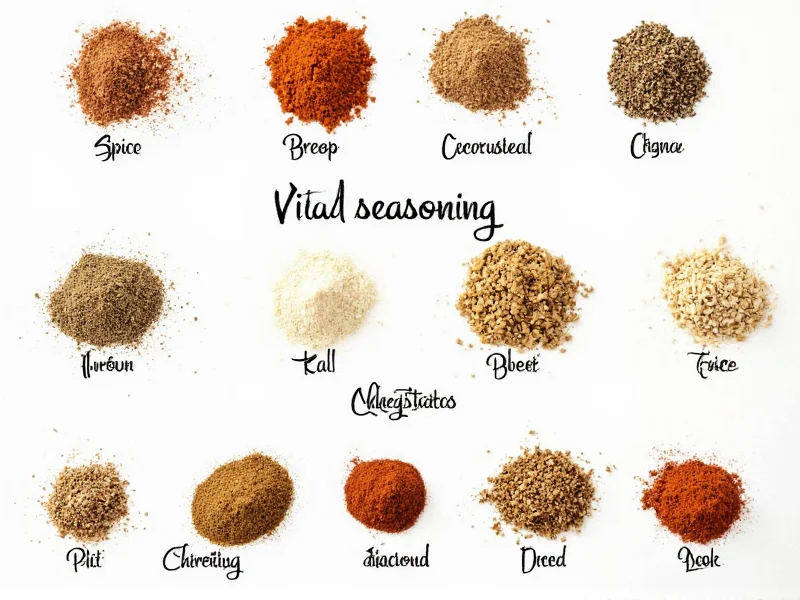Creole seasoning represents the vibrant culinary heritage of New Orleans, blending French, Spanish, African, and Caribbean influences into a distinctive spice profile. Unlike many pre-packaged versions found in grocery stores, authentic Creole seasoning focuses on balanced herb and spice notes rather than overwhelming salt content. Understanding the specific components helps home cooks recreate this essential flavor foundation for gumbo, jambalaya, and other Southern classics.
The Essential Components of Authentic Creole Seasoning
While recipes vary among families and regions, certain spices form the consistent backbone of traditional Creole seasoning. These ingredients work in harmony to create that distinctive New Orleans flavor profile that's aromatic, moderately spicy, and deeply savory.
Paprika: The Color Foundation
Paprika provides both vibrant red color and a sweet, slightly earthy base note. Hungarian or Spanish paprika works best, offering more complexity than standard American paprika. This ingredient distinguishes Creole seasoning from its Cajun cousin, which typically uses less paprika and more cayenne.
Garlic and Onion Powder: The Aromatic Base
These two ingredients form the essential aromatic foundation of Creole seasoning. Unlike fresh garlic and onion, the powdered forms distribute evenly throughout the blend and provide consistent flavor without burning during cooking. The ratio typically favors garlic powder slightly over onion powder for that characteristic New Orleans flavor.
Cayenne Pepper: The Heat Element
Cayenne delivers the signature warmth of Creole seasoning, though in more moderate amounts than in Cajun blends. Authentic Creole seasoning provides a gentle heat that enhances rather than overwhelms other flavors. The amount can be adjusted based on personal preference, but traditional recipes use just enough to provide background warmth.
Black and White Pepper: The Dual Pepper Profile
Using both black and white pepper creates a more complex heat profile than either alone. Black pepper offers sharp, floral notes while white pepper provides deeper, earthier warmth. This combination is a hallmark of traditional Creole seasoning that many commercial blends omit.
Dried Oregano and Thyme: The Herbal Notes
These Mediterranean herbs reflect the French and Spanish influences in Creole cuisine. Oregano contributes a slightly bitter, aromatic quality while thyme adds subtle floral notes. Together, they distinguish Creole seasoning from Cajun blends, which typically use fewer herbs.
| Spice Component | Traditional Amount | Flavor Contribution |
|---|---|---|
| Paprika | 3 parts | Sweet, earthy base with vibrant color |
| Garlic Powder | 2 parts | Pungent, savory depth |
| Onion Powder | 1.5 parts | Sweet, aromatic foundation |
| Cayenne Pepper | 0.5-1 part | Controlled heat element |
| Black Pepper | 1 part | Sharp, floral warmth |
| White Pepper | 0.5 part | Earthy, deep heat |
| Dried Oregano | 1 part | Bitter, aromatic herbal note |
| Dried Thyme | 1 part | Subtle floral herbal note |
Creole vs. Cajun Seasoning: Understanding the Differences
Many home cooks confuse Creole and Cajun seasonings, but they have distinct ingredient profiles. While both originate from Louisiana cuisine, Creole seasoning developed in New Orleans with more European influences, while Cajun seasoning evolved in rural Acadiana with a focus on available local ingredients.
The primary differences include:
- Creole seasoning contains more paprika and herbs (oregano, thyme)
- Cajun seasoning typically has more cayenne and black pepper for greater heat
- Traditional Creole blends include both black and white pepper
- Cajun seasoning rarely contains oregano
- Authentic Creole seasoning has less salt than commercial Cajun blends
Creating Your Own Homemade Creole Seasoning
Making authentic Creole seasoning at home ensures freshness and allows customization to your taste preferences. Commercial blends often contain excessive salt and fillers, while homemade versions focus on the essential spices.
Basic Authentic Creole Seasoning Recipe
This traditional recipe yields approximately 1 cup of seasoning:
- 3 tablespoons paprika (preferably Hungarian or Spanish)
- 2 tablespoons garlic powder
- 1½ tablespoons onion powder
- 1 tablespoon dried oregano
- 1 tablespoon dried thyme
- 1 tablespoon freshly ground black pepper
- ½ tablespoon white pepper
- ½-1 tablespoon cayenne pepper (adjust to heat preference)
- Optional: 1 tablespoon sea salt (add only if desired)
Mix all ingredients thoroughly in a bowl, then transfer to an airtight container. For best flavor, let the mixture rest for 24 hours before use to allow the flavors to meld. This homemade creole seasoning recipe avoids the excessive salt found in many store-bought versions while delivering authentic New Orleans flavor.
Using Creole Seasoning in Your Cooking
Understanding how to properly use Creole seasoning enhances its flavor contribution to dishes. Unlike single spices, this blend works best when incorporated at specific points in the cooking process:
- For meats: Rub generously on proteins 30 minutes before cooking to allow flavors to penetrate
- In soups and stews: Add during the last 20 minutes of cooking to preserve delicate herbal notes
- For vegetables: Toss with oil and seasoning before roasting for maximum flavor absorption
- In dry rubs: Combine with brown sugar for a balanced sweet-heat profile on grilled meats
When substituting for salt in recipes, remember that traditional Creole seasoning contains minimal salt, so you may need to adjust salt levels separately. This knowledge about what spices are in creole seasoning helps you use it more effectively in various cooking applications.
Storage Tips for Maximum Freshness
To maintain the vibrant flavor of your homemade Creole seasoning, proper storage is essential. Whole spices retain freshness longer than ground, but once blended, your seasoning will gradually lose potency.
For optimal shelf life:
- Store in an airtight container away from light and heat
- Keep in a cool, dark cupboard (not above the stove)
- Use within 6 months for peak flavor (though safe indefinitely)
- Refresh the blend by adding 10-15% new spices after 3 months
Notice when your seasoning has lost potency if the aroma is faint or the color has faded significantly. Properly stored, your authentic Creole seasoning blend will deliver consistent, vibrant flavor to all your Louisiana-inspired dishes.











 浙公网安备
33010002000092号
浙公网安备
33010002000092号 浙B2-20120091-4
浙B2-20120091-4